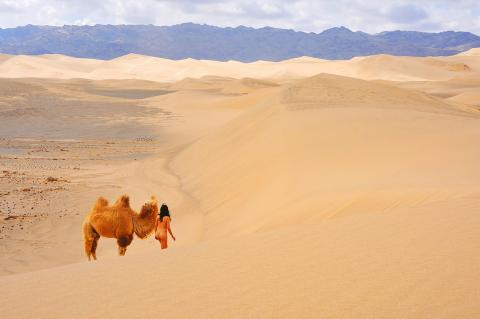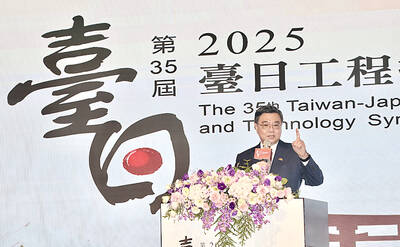Have you ever wondered how a human being can survive alone in the desert?
Exhibiting photographs showing a naked woman alone with camels in a desert, Miru Kim, a young South Korean photographer, tries to portray the vulnerable nature of human beings. She achieves this through composing self-portraits with the camels — animals that humans deeply rely on in that cruel environment.
Having garnered critical acclaim for two series of photographs — Naked City Spleen and The Pig That Therefore I Am — that were exhibited in galleries around the world, Kim is to share parts of her latest unfinished series of photographs — The Camel’s Way — at Kaohsiung’s Pier 2 Arts Center next month.

Photo courtesy of Miru Kim
Related to her previous series — Naked City Spleen, which consisted of nude photographs of the artist in abandoned and underground industrial surroundings, such as deserted factory plants and railways in big cities — her new series takes the focus into real deserts around the world.
“The most difficult part was to get to know the [local] people and make them feel comfortable with what I’m doing,” Kim said.
She added that in addition to the difficulties of working in the extreme weather in deserts, the cultures and religions found in most of these areas do not allow for the exhibition of female nudity.
“I dressed like the locals, ate their food and helped them with daily chores,” she said of her experience of living with nomads for weeks on end in Jordan, Mongolia, Egypt and other desert locations.
This allowed her to really feel and observe the lives of humans in these areas with all her senses, even though at times she could not communicate with the local people in any language, Kim said.
Having initiated the idea of bringing the exhibition to Taiwan, Korean Studies Academy chief executive officer Rick Chu (朱立熙) said while many people in Taiwan have developed a liking for South Korean pop music and TV dramas, he hopes the exhibition can show Taiwanese other dimensions of Korean art.
The exhibition is to run from Jan. 19 to March 3 and admission is free.

ALIGNED THINKING: Taiwan and Japan have a mutual interest in trade, culture and engineering, and can work together for stability, Cho Jung-tai said Taiwan and Japan are two like-minded countries willing to work together to form a “safety barrier” in the Indo-Pacific region, Premier Cho Jung-tai (卓榮泰) yesterday said at the opening ceremony of the 35th Taiwan-Japan Modern Engineering and Technology Symposium in Taipei. Taiwan and Japan are close geographically and closer emotionally, he added. Citing the overflowing of a barrier lake in the Mataian River (馬太鞍溪) in September, Cho said the submersible water level sensors given by Japan during the disaster helped Taiwan monitor the lake’s water levels more accurately. Japan also provided a lot of vaccines early in the outbreak of the COVID-19 pandemic,

Kaohsiung Mayor Chen Chi-mai (陳其邁) on Monday announced light shows and themed traffic lights to welcome fans of South Korean pop group Twice to the port city. The group is to play Kaohsiung on Saturday as part of its “This Is For” world tour. It would be the group’s first performance in Taiwan since its debut 10 years ago. The all-female group consists of five South Koreans, three Japanese and Tainan’s Chou Tzu-yu (周子瑜), the first Taiwan-born and raised member of a South Korean girl group. To promote the group’s arrival, the city has been holding a series of events, including a pop-up

TEMPORAL/SPIRITUAL: Beijing’s claim that the next Buddhist leader must come from China is a heavy-handed political maneuver that will fall flat-faced, experts said China’s requirement that the Dalai Lama’s reincarnation to be born in China and approved by Beijing has drawn criticism, with experts at a forum in Taipei yesterday saying that if Beijing were to put forth its own Dalai Lama, the person would not be recognized by the Tibetan Buddhist community. The experts made a remarks at the two-day forum hosted by the Tibet Religious Foundation of His Holiness the Dalai Lama titled: “The Snow Land Forum: Finding Common Ground on Tibet.” China says it has the right to determine the Dalai Lama’s reincarnation, as it claims sovereignty over Tibet since ancient times,

Temperatures in some parts of Taiwan are expected to fall sharply to lows of 15°C later this week as seasonal northeasterly winds strengthen, the Central Weather Administration (CWA) said today. It is to be the strongest cold wave to affect northern Taiwan this autumn, while Chiayi County in the southwest and some parts of central Taiwan are likely to also see lower temperatures due to radiational cooling, which occurs under conditions of clear skies, light winds and dry weather, the CWA said. Across Taiwan, temperatures are to fall gradually this week, dropping to 15°C to 16°C in the early hours of Wednesday